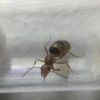- Formiculture.com
- Forums
- Gallery
- Members
- Member Map
- Chat

So this seems like an incorrect ID but…
Started By
FloridaAnts
, Jul 20 2022 12:09 PM
5 replies to this topic
#1
 Offline
-
Posted July 20 2022 - 12:09 PM
Offline
-
Posted July 20 2022 - 12:09 PM
Greetings!
As you may know, I am currently raising a few Camponotus Floridanus queens. Now, when giving one nectar, I noticed something. It didn’t have V on its thorax like the rest… now, it was a bit smaller, but they were all caught in the same area. Then I noticed it. My colony of Camponotus Floridanus also has a smaller queen without a V. So is this a variant? I thought variants were usually found in certain areas, and why would it be smaller? The ones with the V are a little bit bigger(2-4mm)
Queen without a V on thorax
[attachment=12533:B548D407-66B1-4BA0-ABC8-54BB3B965D4E.jpeg]
Queen with a V on thorax
[attachment=12534:4352DE77-2054-4B3E-A928-34C6B7565ADF.jpeg]
Sorry for non perfect V but its good enough
[attachment=12535:9196DF6F-A8D8-40A4-9C91-9C6117F29ECA.jpeg]
As you may know, I am currently raising a few Camponotus Floridanus queens. Now, when giving one nectar, I noticed something. It didn’t have V on its thorax like the rest… now, it was a bit smaller, but they were all caught in the same area. Then I noticed it. My colony of Camponotus Floridanus also has a smaller queen without a V. So is this a variant? I thought variants were usually found in certain areas, and why would it be smaller? The ones with the V are a little bit bigger(2-4mm)
Queen without a V on thorax
[attachment=12533:B548D407-66B1-4BA0-ABC8-54BB3B965D4E.jpeg]
Queen with a V on thorax
[attachment=12534:4352DE77-2054-4B3E-A928-34C6B7565ADF.jpeg]
Sorry for non perfect V but its good enough
[attachment=12535:9196DF6F-A8D8-40A4-9C91-9C6117F29ECA.jpeg]
- FinWins likes this
#2
 Offline
-
Posted July 20 2022 - 12:25 PM
Offline
-
Posted July 20 2022 - 12:25 PM
they both look very similar. Not having a V on the thorax could just be a recessive trait amongst the species. I don’t really know anything about the species. Is the V on the thorax a defining characteristic?Greetings!
As you may know, I am currently raising a few Camponotus Floridanus queens. Now, when giving one nectar, I noticed something. It didn’t have V on its thorax like the rest… now, it was a bit smaller, but they were all caught in the same area. Then I noticed it. My colony of Camponotus Floridanus also has a smaller queen without a V. So is this a variant? I thought variants were usually found in certain areas, and why would it be smaller? The ones with the V are a little bit bigger(2-4mm)
Queen without a V on thoraxB548D407-66B1-4BA0-ABC8-54BB3B965D4E.jpeg
Queen with a V on thorax4352DE77-2054-4B3E-A928-34C6B7565ADF.jpeg
Sorry for non perfect V but its good enough9196DF6F-A8D8-40A4-9C91-9C6117F29ECA.jpeg
Sent from my iPhone using Tapatalk
#3
 Offline
-
Posted July 20 2022 - 5:02 PM
Offline
-
Posted July 20 2022 - 5:02 PM
they both look very similar. Not having a V on the thorax could just be a recessive trait amongst the species. I don’t really know anything about the species. Is the V on the thorax a defining characteristic?Greetings!
As you may know, I am currently raising a few Camponotus Floridanus queens. Now, when giving one nectar, I noticed something. It didn’t have V on its thorax like the rest… now, it was a bit smaller, but they were all caught in the same area. Then I noticed it. My colony of Camponotus Floridanus also has a smaller queen without a V. So is this a variant? I thought variants were usually found in certain areas, and why would it be smaller? The ones with the V are a little bit bigger(2-4mm)
Queen without a V on thoraxB548D407-66B1-4BA0-ABC8-54BB3B965D4E.jpeg
Queen with a V on thorax4352DE77-2054-4B3E-A928-34C6B7565ADF.jpeg
Sorry for non perfect V but its good enough9196DF6F-A8D8-40A4-9C91-9C6117F29ECA.jpeg
Sent from my iPhone using Tapatalk
As I said, it could be a variant, but to me the V one has a bigger head, and larger head.
#4
 Offline
-
Posted July 20 2022 - 8:26 PM
Offline
-
Posted July 20 2022 - 8:26 PM
I’ve found that the V shaped marking is more prominent on some queens than others, even though they are both the same species.
Edited by Manitobant, July 20 2022 - 8:27 PM.
- FloridaAnts likes this
My journals:
Polyergus Mexicanus: https://www.formicul...gs/#entry175528
Lasius minutus: https://www.formicul...cs/#entry174811
Lasius latipes: https://www.formicul...gs/#entry206449
General acanthomyops journal: https://www.formicul...yops-with-eggs/
Polyergus Mexicanus: https://www.formicul...gs/#entry175528
Lasius minutus: https://www.formicul...cs/#entry174811
Lasius latipes: https://www.formicul...gs/#entry206449
General acanthomyops journal: https://www.formicul...yops-with-eggs/
#5
 Offline
-
Posted July 20 2022 - 8:29 PM
Offline
-
Posted July 20 2022 - 8:29 PM
it would be an interesting experiment to see if the smaller queens have no V and the bigger queens do.I’ve found that the V shaped marking is more prominent on some queens than others, even though they are both the same species.
Sent from my iPhone using Tapatalk
#6
 Offline
-
Posted July 21 2022 - 8:53 AM
Offline
-
Posted July 21 2022 - 8:53 AM
I’ve found that the V shaped marking is more prominent on some queens than others, even though they are both the same species.
What’s interesting about these Floridanus variants is the “plain” ones are smaller. Also interesting I have two queens of one, and two of the other, and if one has a v, and The other one does, they are almost identical. Same with the non-v variant.
0 user(s) are reading this topic
0 members, 0 guests, 0 anonymous users














